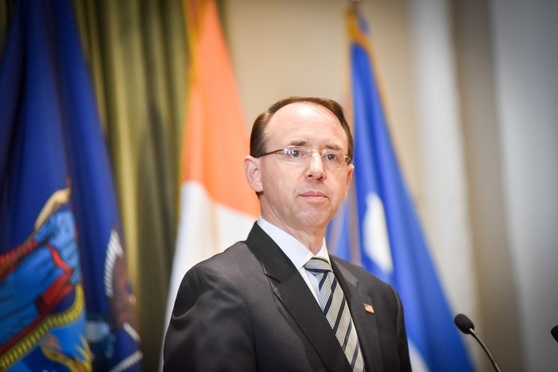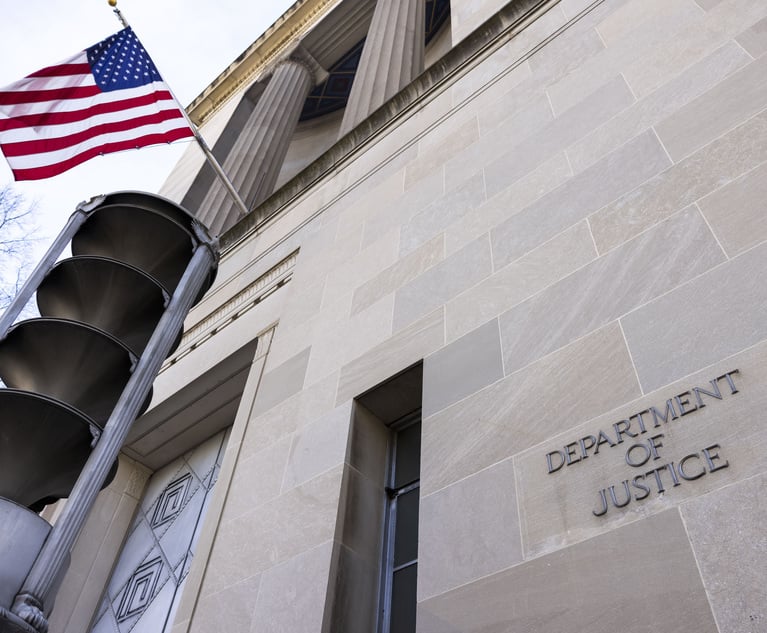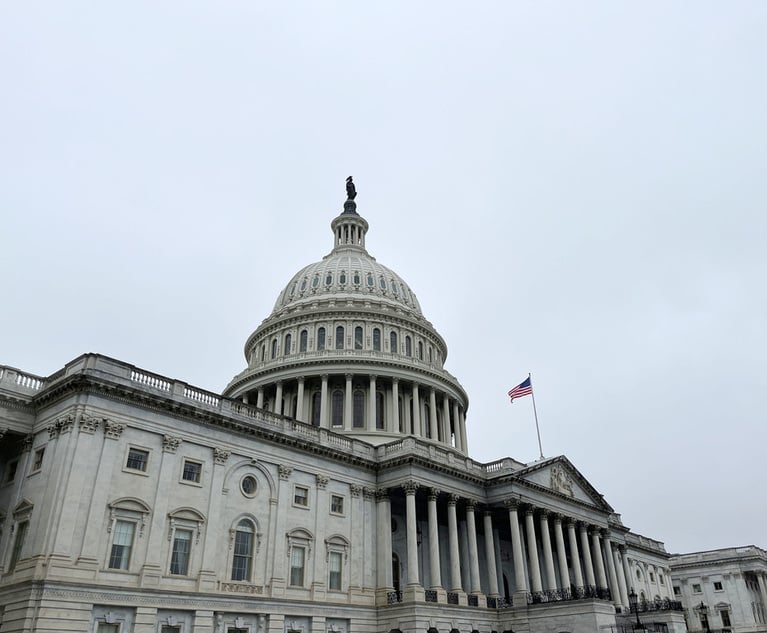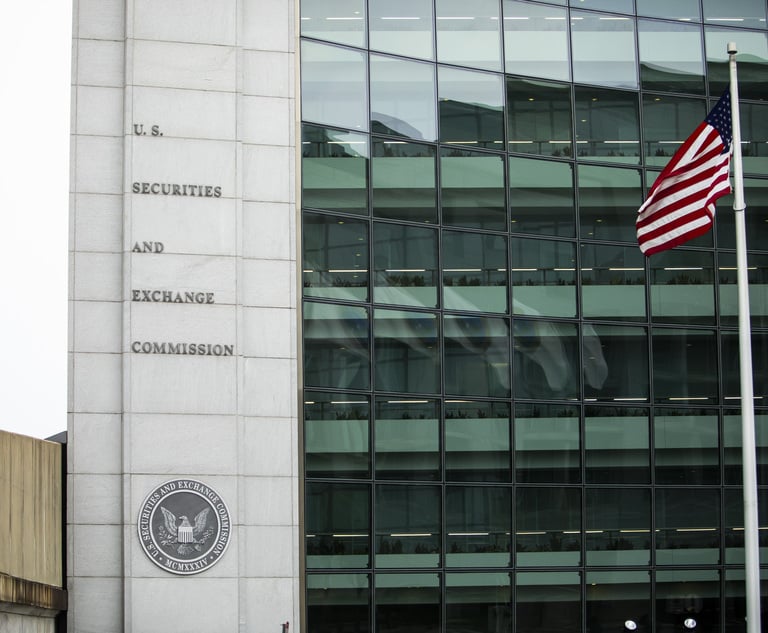The Future of Environmental Enforcement Under the New 'Justice Manual'
The Justice Manual serves as a convenient compilation of hundreds of distinct DOJ policies that guide the work of lawyers at Main Justice and across the 93 U.S. Attorney's Offices.
May 06, 2019 at 04:04 PM
5 minute read
 Rod Rosenstein, Deputy Attorney General of the United States, delivers a lecture on white-collar crime at the New York City Bar on May 9, 2018. Photo: David Handschuh/NYLJ
Rod Rosenstein, Deputy Attorney General of the United States, delivers a lecture on white-collar crime at the New York City Bar on May 9, 2018. Photo: David Handschuh/NYLJ
As he leaves office this week, Deputy Attorney General Rod Rosenstein will be rightfully honored for countless contributions to the rule of law. Among these will be the recently issued Justice Manual and, notably for environmental lawyers (although perhaps missed by some), overseeing reforms impacting environmental enforcement.
The Justice Manual serves as a convenient compilation of hundreds of distinct DOJ policies that guide the work of lawyers at Main Justice and across the 93 U.S. Attorney's Offices. For the public, it is also a helpful resource for better understanding the DOJ generally. Updating the Justice Manual—the first such effort in 20 years—has made a valuable contribution to law enforcement and good government. And, taken together, the Justice Manual and related reforms at the Environment and Natural Resources Division (ENRD) and elsewhere at the DOJ should improve environmental enforcement in several ways.
First, the Justice Manual recalibrates how the DOJ prosecutes cases, including environmental enforcement matters.
For example, the Justice Manual now limits the use of agency guidance documents. In environmental matters, where the government's case often involves reference to a complex mix of statutes, regulations, agency documents and industry practices, this change should have real impacts. The manual still allows prosecutors to use guidance documents for “evidentiary purposes,” among other things, so long as they “do not treat such documents as creating by themselves binding requirements that do not already exist by statute or regulation.” Moreover, by requiring prosecutors to charge and pursue the “most serious, readily provable offenses,” the Justice Manual should lead environmental prosecutors to pursue targeted charges focused on the most serious violations.
Second, the Justice Manual clarifies the circumstances under which companies may receive “cooperation credit” for working with federal prosecutors to expose criminal acts by individuals.
For these purposes, corporations must disclose individuals who were “substantially involved in or responsible for the criminal conduct,” not every individual, regardless of culpability as previously required. For civil cases, the Justice Manual explains that the amount of credit depends on the level of cooperation, with “maximum credit” for “timely self-analysis” and “proactive” voluntary disclosure and lesser credit for cooperation that is imperfect yet “meaningful.”
Third, the Justice Manual reforms how DOJ resolves civil and criminal environmental cases.
In cases involving multiple federal, state or local enforcement authorities (a common dynamic in environmental matters), the manual calls for greater coordination and seeks to “avoid the unnecessary imposition of duplicative fines, penalties and/or forfeiture against the company.” In Rosenstein's words, federal prosecutors should avoid “piling on.”
Further, the Justice Manual bans payments to third parties in civil and criminal settlements except where the payment is done to directly remedy the harm, particularly the environmental harm, caused by the violation. Recent DOJ policies also reiterate that environmental mitigation—a frequent component of relief in environmental cases—should be calculated to address the extent of actual harm and cannot be used to penalize defendants. These two reforms may do more to impact environmental settlements than any other recent change.
Additionally, a November 2018 directive from former Attorney General Jeff Sessions limits the use of consent decrees in civil enforcement cases against state and local governments. Frequently, cities and counties are defendants in water, sewer and other environmental cases. Under the Sessions policy, consent decrees with government entities should be reviewed at higher levels within the DOJ, “narrowly tailored,” and of limited duration (with recognition for special scenarios where “extended compliance schedules” are needed for “significant capital investments”).
Fourth, new DOJ documents help clarify the line—sometimes blurred in environmental cases—between events that may lead to criminal prosecution as opposed to civil enforcement alone.
Unlike most criminal laws, some federal environmental statutes, such as the Clean Water Act and Clean Air Act, impose criminal liability for negligence or, as is the case under the Migratory Bird Treaty Act, for acts with no criminal mindset at all. Recent ENRD memoranda, while not expressly included in the Justice Manual, emphasize that evidence for “potential criminal liability” in environmental cases includes “evidence of falsification of data, concealment of evidence, or repeated violations despite prior enforcement efforts.”
These ENRD documents also explain that criminal prosecution is “most likely” to occur “where the facts show a requisite criminal intent, and the conduct creates a serious danger or risk of danger, has severe environmental effects, disregards human safety or the environment, involves dishonest or false conduct that undermines the statutory scheme, or involves repetitive significant violations notwithstanding administrative and civil enforcement efforts to obtain compliance.” Bearing these distinctions in mind should prove helpful to prosecutors and defense attorneys alike as they evaluate enforcement paths in specific cases.
Undoubtedly, the Rosenstein tenure, the Justice Manual and related policies will shape federal enforcement—including environmental enforcement—for years to come. As Rosenstein said in remarks at a recent ENRD ceremony, the DOJ exists to “enforce the laws enacted by the Congress” and “federal enforcement focuses on the pursuit of the truth, wherever the facts may lead.”
Jeffrey H. Wood served as the Acting Assistant Attorney General for the DOJ's Environment and Natural Resources Division from Jan. 20, 2017 through Oct. 31, 2018. He is currently a partner in the Environmental Law Practice of Baker Botts in Washington, D.C.
This content has been archived. It is available through our partners, LexisNexis® and Bloomberg Law.
To view this content, please continue to their sites.
Not a Lexis Subscriber?
Subscribe Now
Not a Bloomberg Law Subscriber?
Subscribe Now
NOT FOR REPRINT
© 2025 ALM Global, LLC, All Rights Reserved. Request academic re-use from www.copyright.com. All other uses, submit a request to [email protected]. For more information visit Asset & Logo Licensing.
You Might Like
View All
Government Attorneys Face Reassignment, Rescinded Job Offers in First Days of Trump Administration
4 minute read
RFK Jr. Will Keep Affiliations With Morgan & Morgan, Other Law Firms If Confirmed to DHHS
3 minute read
Am Law 200 Firms Announce Wave of D.C. Hires in White-Collar, Antitrust, Litigation Practices
3 minute readTrending Stories
Who Got The Work
J. Brugh Lower of Gibbons has entered an appearance for industrial equipment supplier Devco Corporation in a pending trademark infringement lawsuit. The suit, accusing the defendant of selling knock-off Graco products, was filed Dec. 18 in New Jersey District Court by Rivkin Radler on behalf of Graco Inc. and Graco Minnesota. The case, assigned to U.S. District Judge Zahid N. Quraishi, is 3:24-cv-11294, Graco Inc. et al v. Devco Corporation.
Who Got The Work
Rebecca Maller-Stein and Kent A. Yalowitz of Arnold & Porter Kaye Scholer have entered their appearances for Hanaco Venture Capital and its executives, Lior Prosor and David Frankel, in a pending securities lawsuit. The action, filed on Dec. 24 in New York Southern District Court by Zell, Aron & Co. on behalf of Goldeneye Advisors, accuses the defendants of negligently and fraudulently managing the plaintiff's $1 million investment. The case, assigned to U.S. District Judge Vernon S. Broderick, is 1:24-cv-09918, Goldeneye Advisors, LLC v. Hanaco Venture Capital, Ltd. et al.
Who Got The Work
Attorneys from A&O Shearman has stepped in as defense counsel for Toronto-Dominion Bank and other defendants in a pending securities class action. The suit, filed Dec. 11 in New York Southern District Court by Bleichmar Fonti & Auld, accuses the defendants of concealing the bank's 'pervasive' deficiencies in regards to its compliance with the Bank Secrecy Act and the quality of its anti-money laundering controls. The case, assigned to U.S. District Judge Arun Subramanian, is 1:24-cv-09445, Gonzalez v. The Toronto-Dominion Bank et al.
Who Got The Work
Crown Castle International, a Pennsylvania company providing shared communications infrastructure, has turned to Luke D. Wolf of Gordon Rees Scully Mansukhani to fend off a pending breach-of-contract lawsuit. The court action, filed Nov. 25 in Michigan Eastern District Court by Hooper Hathaway PC on behalf of The Town Residences LLC, accuses Crown Castle of failing to transfer approximately $30,000 in utility payments from T-Mobile in breach of a roof-top lease and assignment agreement. The case, assigned to U.S. District Judge Susan K. Declercq, is 2:24-cv-13131, The Town Residences LLC v. T-Mobile US, Inc. et al.
Who Got The Work
Wilfred P. Coronato and Daniel M. Schwartz of McCarter & English have stepped in as defense counsel to Electrolux Home Products Inc. in a pending product liability lawsuit. The court action, filed Nov. 26 in New York Eastern District Court by Poulos Lopiccolo PC and Nagel Rice LLP on behalf of David Stern, alleges that the defendant's refrigerators’ drawers and shelving repeatedly break and fall apart within months after purchase. The case, assigned to U.S. District Judge Joan M. Azrack, is 2:24-cv-08204, Stern v. Electrolux Home Products, Inc.
Featured Firms
Law Offices of Gary Martin Hays & Associates, P.C.
(470) 294-1674
Law Offices of Mark E. Salomone
(857) 444-6468
Smith & Hassler
(713) 739-1250









